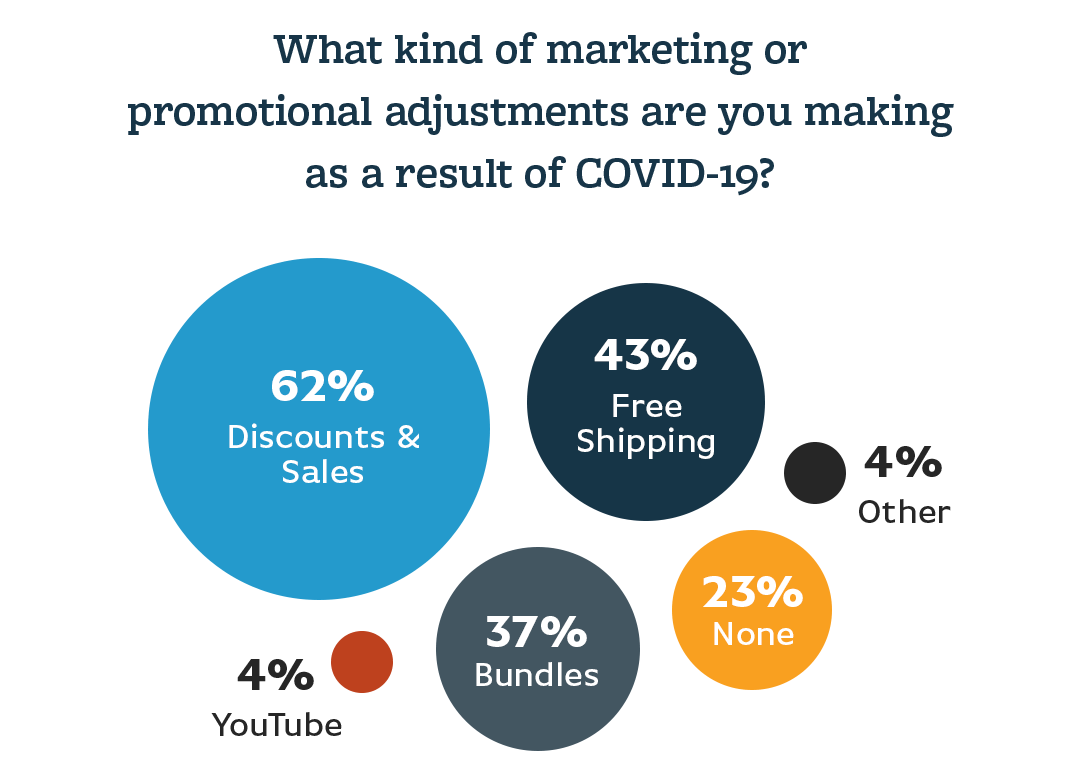When it comes to making the sale, having great inventory is just one piece of the puzzle. Especially in the current economy, customers are on the hunt for high-quality products at reasonable prices. It’s up to you to convince them your store has the best of both. That’s where marketing comes in.
If done correctly, marketing can both expand your buyer base and entice your previous customers to make another purchase. Though some strategies require an investment, the increase in profits can make the upfront cost well worth it.
We asked more than 400 BULQ customers about their go-to marketing strategies during COVID-19. Even outside a pandemic, these methods can be useful for boosting business and getting customers in your *virtual* door. Read on for a few of their favorite strategies and how to apply them to your store.
Discounts and Sales
Who doesn’t love a good deal? Sales are one of the most popular marketing strategies during COVID-19 to make listings stand out from the rest. But, before you start slashing prices, there are a few discount strategies to consider.
- Discount Aging Inventory: Have certain listings been sitting on your store for months? These items should be your first candidates for a sale. Marking down aging inventory not only makes the items more desirable to customers, but also allows you to clear space for more in-demand products. Some sellers even make a habit of reviewing inventory and regularly discounting what’s slow to sell.
- Discount Specific Categories: If you’re working with a surplus of seasonal inventory or a specific type of item, consider marking down just those categories. Especially with COVID-19 disrupting seasonal buying patterns, category-specific sales can entice customers to buy out-of-season inventory and encourage purchases of typical in-season products.
- Discount Your Entire Store: Though it may feel a little risky, offering a store-wide sale is a tried and true method of grabbing customers’ attention. Before settling on a discount, run the numbers and see where you can slash prices to still make a profit. Even 10-15% off can be enough to get buyers browsing without seriously cutting into your margins.
Free Shipping
In the wake of Amazon’s ecommerce takeover, consumers are becoming accustomed to fast, easy, and free shipping. In fact, behind discounts, 75% of shoppers ranked free shipping as the most appealing promotional offer in 2018.
So, how do you offer free shipping without breaking the bank?
- Wrap shipping expenses into an item’s price and offer “free shipping” that’s still covered by the total purchase cost.
- Evaluate your total business budget to see if there’s any room to allocate funds toward shipping and handling costs.
- Offer free shipping for orders of a certain value to offset the total shipping cost while encouraging customers to buy multiple items.
Before committing to a store-wide strategy, play with the cost of products and their shipping to see what resonates with customers. For example- list a product for $30 with free shipping, then re-list it a few weeks later at $25 with $5 shipping to compare sales.
Bundles
Offering multiple, similar products together for a single price can benefit both your and your customers’ budgets. Customers receive a lower price per item than if they were to buy the products individually. As a result, sellers typically see a higher average order value since buyers are purchasing multiple products.
Bundles are also a great opportunity to save on shipping. Light, low price items can often wind up costing sellers money in shipping fees. Instead of sending those products on their own, bundle them with similar, higher-priced items to balance out shipping costs.
To take it a step further, consider creating special “gift packs” or “baskets” that align with events and holidays. This not only gives customers a great price, but also does the work of gifting for them. Don’t forget to add in some finishing touches, like wrapping or ribbon, to offer buyers the full package.
Email and Social Media
Sometimes, the best marketing methods don’t cost a dime! Both email and social media enable sellers to get their products (and promotions) directly in front of customers.
For email, test out sending alerts to your existing customers. These emails can continually remind them about all your store has to offer. A few topic ideas can include:
- Monthly newsletters with general updates and trending products
- Product alerts for new or updated listings
- Special discounts or promo alerts
Try a few different subject lines and send at different times of day to see what customers best respond to. Also, create a schedule or calendar to prevent overloading buyers with multiple emails within the same few days.
Facebook, Twitter, Instagram, and YouTube are also all great channels for reaching current and potential customers, especially during COVID-19. If you haven’t done so already, create a social profile for your store and update it regularly with new listings, promotions and reminders about your store’s selection.
To up your social media game, try sharing behind-the-scenes content, such as a video of you unboxing inventory or packing orders, to further the relationship with your buyers. Answering customer questions, either in a live video or in the comments of a post, is also a great way to build trust among new or potential customers.
—
With so many sellers to choose from, it may feel hard to stand out in the sea of online reselling. But, with just a few basic marketing strategies during COVID-19, your business can get that extra push to get in front of customers and keep them coming back for more.





No comments yet.